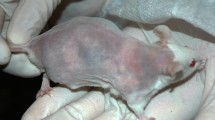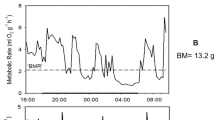Abstract
Lactation is the most energetically demanding physiological process that occurs in mammalian females, and as a consequence of this energy expenditure, lactating females produce an enormous amount of excess heat. This heat is thought to limit the amount of milk a mother produces, and by improving heat dissipation, females may improve their milk production and offspring quality. Here we used SKH-1 hairless mice as a natural model of improved heat dissipation. Lactating mothers were given access to a secondary cage to rest away from their pups, and this secondary cage was kept either at room temperature (22 °C) in the control rounds or cooled to 8 °C in the experimental groups. We hypothesized that the cold exposure would maximize the heat dissipation potential, leading to increased milk production and healthier pups even in the hairless mouse model. However, we found the opposite, where cold exposure allowed mothers to eat more food, but they produced smaller weight pups at the end of lactation. Our results suggest that mothers prioritize their own fitness, even if it lowers the fitness of their offspring in this particular mouse strain. This maternal–offspring trade-off is interesting and requires future studies to understand the full interaction of maternal effects and offspring fitness in the light of the heat dissipation limitation.





Similar content being viewed by others
Data availability
All data generated for this manuscript can be found in Supplementary Materials.
References
Bates D, Maechler M, Bolker B, Walker S (2015) Fitting linear mixed-effects models using lme4. J Stat Softw 67(1):1–48. https://doi.org/10.18637/jss.v067.i01
Gamo Y, Bernard A, Troup C, Munro F, Derrer K, Jeannesson N, Campbell A, Gray H, Miller J, Dixon J, Mitchell SE, Hambly C, Vaanholt LM, Speakman JR (2016) Limits to sustained energy intake XXIV: impact of suckling behaviour on the body temperatures of lactating female mice. Sci Rep 6:25665. https://doi.org/10.1038/srep25665
Godfray HCJ, Parker GA (1991) Clutch size, fecundity and parent-offspring conflict. Proc R Soc B 332(1262):67–79. https://doi.org/10.1098/rstb.1991.0034
Hammond KA, Konarzewski M, Torres RM, Diamond J (1994) Metabolic ceilings under a combination of peak energy demands. Physiol Zoo 67:1479–1506
Johnson MS, Speakman JR (2001) Limits to sustained energy intake. V. Effect of cold-exposure during lactation in Mus musculus. J Exp Biol 204(Pt 11):1967–1977
Johnson MS, Thomson SC, Speakman JR (2001) Limits to sustained energy intake. I. Lactation in the laboratory mouse Mus musculus. J Exp Biol 204(Pt 11):1925–1935. https://doi.org/10.1242/jeb.204.11.1925
Koteja P (1996) Limits to the energy budget in a rodent, Peromyscus maniculatus: does gut capacity set the limit? Physiol Zoo 69:994–1020
Krol E, Murphy M, Speakman JR (2007) Limits to sustained energy intake. X. Effects of fur removal on reproductive performance in laboratory mice. J Exp Biol 210(Pt 23):4233–4243. https://doi.org/10.1242/jeb.009779
Krol E, Martin SA, Huhtaniemi IT, Douglas A, Speakman JR (2011) Negative correlation between milk production and brown adipose tissue gene expression in lactating mice. J Exp Biol 214(Pt 24):4160–4170. https://doi.org/10.1242/jeb.061382
Marshall DJ, Uller T (2007) When is a maternal effect adaptive? Oikos 116:1957–1963. https://doi.org/10.1111/j.2007.0030-1299.16203.x
Marshall DJ, Heppell SS, Munch SB, Warner RR (2010) The relationship between maternal phenotype and offspring quality: do older mothers really produce the best offspring? Ecology 91(10):2862–2873. https://doi.org/10.1890/09-0156.1
Mousseau TA, Fox CW (1998) The adaptive significance of maternal effects. Trends Ecol Evol 13(10):403–407. https://doi.org/10.1016/s0169-5347(98)01472-4
Ohrnberger SA, Monclus R, Rodel HG, Valencak TG (2016) Ambient temperature affects postnatal litter size reduction in golden hamsters. Front Zool 13:51. https://doi.org/10.1186/s12983-016-0183-8
Ohrnberger SA, Brinkmann K, Palme R, Valencak TG (2018a) Dorsal shaving affects concentrations of faecal cortisol metabolites in lactating golden hamsters. Naturwissenschaften 105(1–2):13. https://doi.org/10.1007/s00114-017-1536-7
Ohrnberger SA, Hambly C, Speakman JR, Valencak TG (2018b) Limits to sustained energy intake. XXIX. The case of the golden hamster (Mesocricetus auratus). J Exp Biol. https://doi.org/10.1242/jeb.183749
Ohrnberger SA, Hambly C, Speakman JR, Valencak TG (2020) Limits to sustained energy intake. XXXII. Hot again: dorsal shaving increases energy intake and milk output in golden hamsters (Mesocricetus auratus). J Exp Biol. https://doi.org/10.1242/jeb.230383
Sadowska J, Gebczynski AK, Lewoc M, Konarzewski M (2019) Not that hot after all: no limits to heat dissipation in lactating mice selected for high or low BMR. J Exp Biol. https://doi.org/10.1242/jeb.204669
Simons MJ, Reimert I, van der Vinne V, Hambly C, Vaanholt LM, Speakman JR, Gerkema MP (2011) Ambient temperature shapes reproductive output during pregnancy and lactation in the common vole (Microtus arvalis): a test of the heat dissipation limit theory. J Exp Biol 214(Pt 1):38–49. https://doi.org/10.1242/jeb.044230
Speakman JR, Krol E (2010) Maximal heat dissipation capacity and hyperthermia risk: neglected key factors in the ecology of endotherms. J Anim Ecol 79(4):726–746. https://doi.org/10.1111/j.1365-2656.2010.01689.x
Tomasi TE, Horton TH (1992) Mammalian energetics: interdisciplinary views of metabolism and reproduction. Cornell University Press. https://doi.org/10.7591/9781501737978
Valencak TG, Ruf T (2009) Energy turnover in European hares is centrally limited during early, but not during peak lactation. J Comp Physiol B 179(8):933–943. https://doi.org/10.1007/s00360-009-0376-y
Valencak TG, Tataruch F, Ruf T (2009) Peak energy turnover in lactating European hares: the role of fat reserves. J Exp Biol 212(Pt 2):231–237. https://doi.org/10.1242/jeb.022640
Valencak TG, Hacklander K, Ruf T (2010) Peak energy turnover in lactating European hares: a test of the heat dissipation limitation hypothesis. J Exp Biol 213(Pt 16):2832–2839. https://doi.org/10.1242/jeb.040238
Valencak TG, Wright P, Weir A, Mitchell SE, Vaanholt LM, Hambly C, Krol E, Speakman JR (2013) Limits to sustained energy intake. XXI. Effect of exposing the mother, but not her pups, to a cold environment during lactation in mice. J Exp Biol 216(Pt 23):4326–4333. https://doi.org/10.1242/jeb.092023
Wu SH, Zhang LN, Speakman JR, Wang DH (2009) Limits to sustained energy intake. XI. A test of the heat dissipation limitation hypothesis in lactating Brandt’s voles (Lasiopodomys brandtii). J Exp Biol 212(Pt 21):3455–3465. https://doi.org/10.1242/jeb.030338
Yang DB, Li L, Wang LP, Chi QS, Hambly C, Wang DH, Speakman JR (2013) Limits to sustained energy intake. XIX. A test of the heat dissipation limitation hypothesis in Mongolian gerbils (Meriones unguiculatus). J Exp Biol 216(Pt 17):3358–3368. https://doi.org/10.1242/jeb.085233
Zhao ZJ (2012) Effect of cold exposure on energy budget and thermogenesis during lactation in Swiss mice raising large litters. Biol Open 1(4):397–404. https://doi.org/10.1242/bio.2012661
Zhao ZJ, Cao J (2009) Effect of fur removal on the thermal conductance and energy budget in lactating Swiss mice. J Exp Biol 212(Pt 16):2541–2549. https://doi.org/10.1242/jeb.029603
Zhao ZJ, Chi QS, Cao J (2010) Milk energy output during peak lactation in shaved Swiss mice. Physiol Behav 101(1):59–66. https://doi.org/10.1016/j.physbeh.2010.04.017
Acknowledgements
Our study was made possible with the help of several students including Maria Thaler, Denise Martinkovich, Anna Mokry and Rene Haider. For his help with setting up the two-chambered cages at the Vetmeduni campus, we thank Andreas Stiedl, who swiftly adapted the cage lids to the PVC tubes. Several placement students also assisted with measurements and welfare of the animals. We thank the two anonymous reviewers for their insightful comments that greatly improved the manuscript.
Funding
JMH is partially funded by the National Institutes of Health R00AG059920. TGV was funded by P 26 246-B17 from the Austrian Science Foundation FWF during the course of the project.
Author information
Authors and Affiliations
Contributions
BS, JUP, SAO, and TGV designed the experiment. BS, JUP, and SAO carried out the animal work. JMH and TGV analyzed the data and made the figures. JMH and TGV wrote the first draft of the manuscript. All authors edited and approved the final manuscript.
Corresponding author
Ethics declarations
Conflict of interest
The authors have no conflicts of interest to disclose.
Ethics approval
All experiments described in this manuscript were approved by the Ethics Committee of the University of Veterinary Medicine, Vienna, and the Austrian Ministry of Science (approval number GZ 68.205/0101-WF/V/3b/2018).
Additional information
Communicated by G. Heldmaier.
Publisher's Note
Springer Nature remains neutral with regard to jurisdictional claims in published maps and institutional affiliations.
Supplementary Information
Below is the link to the electronic supplementary material.
Rights and permissions
Springer Nature or its licensor (e.g. a society or other partner) holds exclusive rights to this article under a publishing agreement with the author(s) or other rightsholder(s); author self-archiving of the accepted manuscript version of this article is solely governed by the terms of such publishing agreement and applicable law.
About this article
Cite this article
Hoffman, J.M., Schmitz, B., Pfabe, J.U. et al. Lactating SKH-1 furless mice prioritize own comfort over growth of their pups. J Comp Physiol B 193, 453–459 (2023). https://doi.org/10.1007/s00360-023-01498-1
Received:
Revised:
Accepted:
Published:
Issue Date:
DOI: https://doi.org/10.1007/s00360-023-01498-1




